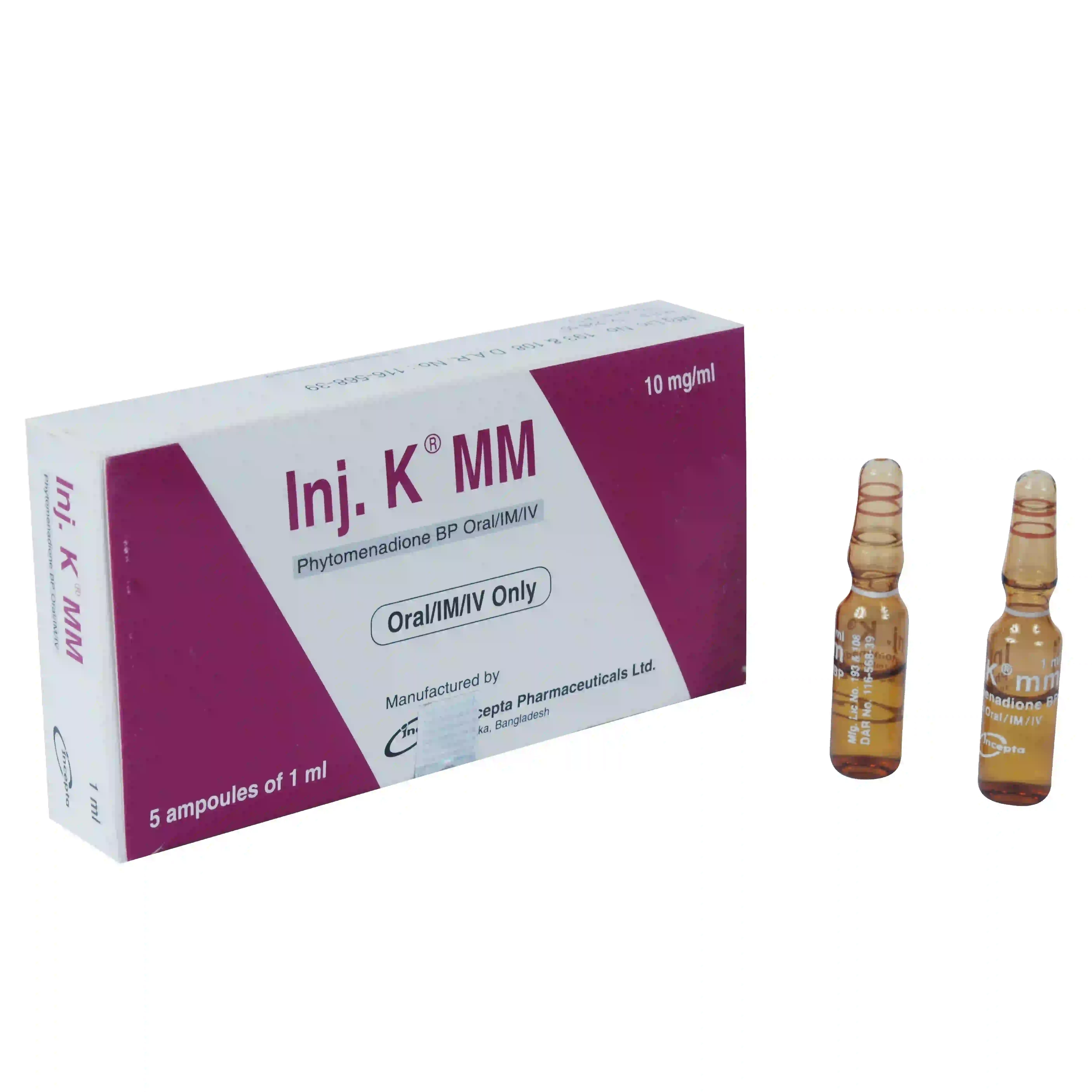10 mg ampoule:
৳ 45.86
(1 x 5: ৳ 229.30)
Also available as:
Indications
Inj. K MM (Vitamin K-1) is indicated in following indications-
- Prophylaxis and treatment of haemorrhagic disease in the newborn.
- Haemorrhage or risk of haemorrhage as a result of severe hypoprothrombinemia (i.e. deficiency of clotting factors II, VII, IX and X) of various etiologies, including overdosage of courmarin-type anticoagulants, their combination with phenylbutazone, and other forms of hypovitaminosis K (e.g. in obstructive jaundice as well as liver and intestinal disorders, and after prolonged treatment with antibiotics, sulphonamides or salicylates).
- Prevention and treatment of bleeding due to vitamin K deficiency.
Pharmacology
Phytomenadione is a procoagulant factor. As a component of a hepatic carboxylase system, Phytomenadione is involved in the post translational carboxylation of clotting factors II (prothrombin), VII, IX and X and the clotting inhibitors protein C and protein S. Phytomenadione is ineffective in hereditary hypoprothrombinemia or hypoprothrombinemia induced by severe hepatic failure. Lack of Phytomenadione leads to an increased tendency to haemorrhagic disease in the newborn. Phytomenadione administration, which promotes synthesis of the above-mentioned coagulation factors by the liver, can reverse an abnormal coagulation status and bleeding due to Phytomenadione deficiency.
Dosage & Administration
Prophylaxis: Mild Hemorrhage or hemorrhagic tendency: The usual dose for Neonates is 2 mg orally at or just after birth. Then 2 mg on 4th-5th day and another 2 mg on 28th-30th day orally. If the oral route is unsuitable then 2 mg of drug can be administered by IM or IV route.
Children over 1 year of age: Could be given 5-10 mg orally. A single 1 mg (0.1 ml) dose IM is recommended in children who are not assured of receiving a second oral dose or, in the case of breast-fed children, who are not assured of receiving a third oral dose.
Therapy: Initially, 1 mg by intravenous injection, with further doses as required, based on the clinical picture and coagulation status.
Neonates with special risk factors: Pre-maturity, birth asphyxia (inadequate intake of oxygen by the baby during birth process), obstructive jaundice, inability to swallow, maternal use of anticoagulants or anti-epileptics-
Children over 1 year of age: Could be given 5-10 mg orally. A single 1 mg (0.1 ml) dose IM is recommended in children who are not assured of receiving a second oral dose or, in the case of breast-fed children, who are not assured of receiving a third oral dose.
Therapy: Initially, 1 mg by intravenous injection, with further doses as required, based on the clinical picture and coagulation status.
Neonates with special risk factors: Pre-maturity, birth asphyxia (inadequate intake of oxygen by the baby during birth process), obstructive jaundice, inability to swallow, maternal use of anticoagulants or anti-epileptics-
- 1 mg intramuscularly or intravenously at birth or shortly after birth if the oral route is unsuitable.
- Intramuscular and intravenous doses should not exceed 0.4 mg/kg in premature infants weighing less than 2.5 kg.
- The size and frequency of further doses should be based on coagulation status
Interaction
Inj. K MM antagonises the effect of coumarin-type anticoagulants. Coadministration of anticonvulsants can impair the action of vitamin K-1.
Contraindications
It is contraindicated in patients with known hypersensitivity to any of its constituents.
Side Effects
There are isolated unconfirmed reports on the possible occurrence of anaphylactoid reactions and venous irritation or phlebitis after parenteral use of Inj. K MM injections.
Precautions & Warnings
Careful monitoring of the coagulation parameters is necessary for patients with severely impaired liver function after administration of Inj. K MM .
Therapeutic Class
Vitamin-K Preparations
Storage Conditions
Keep below 30°C temperature, away from light & moisture. Keep out of the reach of children.


